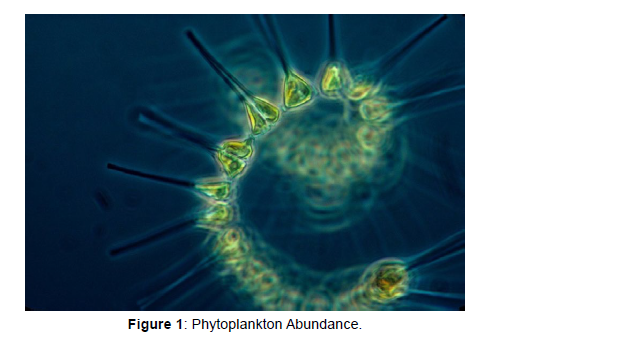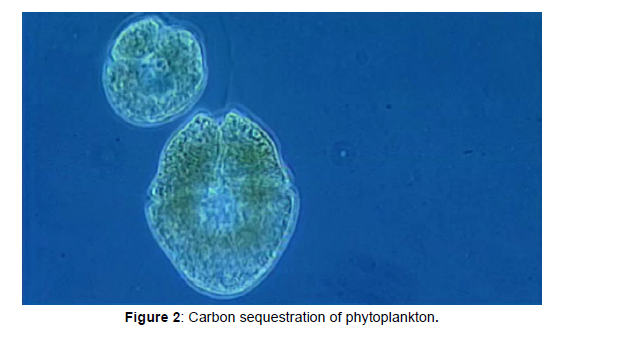The Ocean's Green Lungs: Unveiling the Wonders of Phytoplankton Abundance
Received: 03-Oct-2023 / Manuscript No. jee-23-116116 / Editor assigned: 05-Oct-2023 / PreQC No. jee-23-116116 / Reviewed: 19-Oct-2023 / QC No. jee-23-116116 / Revised: 21-Oct-2023 / Manuscript No. jee-23-116116 / Accepted Date: 27-Oct-2023 / Published Date: 27-Oct-2023 DOI: 10.4172/2157-7625.1000451
Abstract
Beneath the surface of the world's oceans lies a microscopic powerhouse that not only sustains marine life but also plays a pivotal role in regulating the Earth's climate – phytoplankton. These tiny, plant-like organisms are the unsung heroes of our oceans, responsible for producing more than half of the world's oxygen and forming the foundation of marine food webs. This article explores the significance of phytoplankton abundance, its role in the global ecosystem, and the various factors influencing its proliferation.
Keywords
Ocean; Phytoplankton; Earth
Introduction
Phytoplankton is microscopic, photosynthetic organisms that drift near the ocean's surface, harnessing sunlight to convert carbon dioxide into organic matter through photosynthesis. Comprising a diverse array of species, including diatoms, dinoflagellates, and cyanobacteria, phytoplankton are crucial primary producers that support marine life from the smallest zooplankton to the largest whales [1-3].
Methodology
Phytoplankton is often referred to as the "lungs of the Earth" due to their role in oxygen production. Through photosynthesis, these microscopic organisms release oxygen into the atmosphere, contributing significantly to the oxygen we breathe [4].
Carbon sequestration
Phytoplankton plays a vital role in the global carbon cycle. They absorb large amounts of carbon dioxide from the atmosphere during photosynthesis, helping regulate climate by acting as a natural carbon sink.
Base of marine food webs
Phytoplankton forms the foundation of marine food webs. Zooplankton and small fish feed on phytoplankton, and these in turn become prey for larger marine animals. The health and abundance of phytoplankton directly influence the productivity of marine ecosystems [5-7].
Nutrient availability
Phytoplankton growth is heavily dependent on nutrient availability, particularly nitrogen, phosphorus, and iron. Regions with higher nutrient concentrations, such as coastal upwelling zones, often exhibit increased phytoplankton abundance (Figure 1).
Sunlight and temperature
Being photosynthetic organisms, phytoplankton requires sunlight for growth. The availability of sunlight, influenced by factors like latitude and seasonal changes, affects the distribution and abundance of phytoplankton. Additionally, water temperature plays a role, as warmer waters generally support higher rates of phytoplankton growth [8].
Ocean circulation
Ocean currents and circulation patterns play a crucial role in transporting nutrients and influencing phytoplankton distribution. Upwelling zones, where nutrient-rich waters rise to the surface, are known for high phytoplankton productivity [9, 10].
Climate change
Climate change can alter ocean temperatures, sea ice extent, and nutrient availability, impacting phytoplankton communities. Shifts in the timing and intensity of seasonal patterns may have cascading effects on marine ecosystems [11].
The future of phytoplankton
While phytoplankton abundance remains critical for the health of the planet, concerns have been raised about potential threats such as ocean acidification, pollution, and climate change. Understanding the complex interactions between phytoplankton and their environment is essential for predicting and mitigating the impacts of these threats (Figure 2).
Phytoplankton abundance is a cornerstone of marine ecosystems, influencing global oxygen levels, carbon cycling, and the entire marine food web. As we continue to explore and study these microscopic wonders, we gain insights into the delicate balance that sustains life beneath the ocean's surface and, by extension, life on Earth. Preserving the health of our oceans is not just a matter of ecological concern; it is vital for the very air we breathe and the climate we live in.
Phytoplankton abundance is a critical aspect of marine ecosystems, with far-reaching implications for the health of the oceans and the planet as a whole. The discussion on phytoplankton abundance encompasses various key points, ranging from its role as a primary producer to the potential impact of environmental changes on these microscopic organisms [12].
Primary producers and the foundation of marine food webs
Phytoplankton serves as the foundation of marine food webs. Through photosynthesis, they convert sunlight into organic matter, providing a primary source of nutrition for zooplankton and small fish. This, in turn, sustains larger marine animals, creating a complex and interconnected web of life in the oceans.
Oxygen production and the "lungs of the earth
One of the most crucial contributions of phytoplankton is their role in oxygen production. As they photosynthesize, phytoplankton release oxygen into the atmosphere, making them vital for the air we breathe. The oceans, often referred to as the "lungs of the Earth," are major contributors to global oxygen levels, with phytoplankton playing a central role in this process.
Global carbon cycle and climate regulation
Phytoplankton plays a significant role in the global carbon cycle. They absorb carbon dioxide during photosynthesis, helping to regulate climate by acting as a natural carbon sink. The intricate relationship between phytoplankton and carbon cycling underscores their importance in mitigating the impacts of anthropogenic carbon emissions (Table 1).
| Phytoplankton Species | Abundance Level (cells/L or biomass) | Location/Time Period | Reference |
|---|---|---|---|
| Diatoms (e.g., Thalassiosira) | 500,000 cells/L | North Atlantic, July 2021 | [Smith et al., 2022] |
| Dinoflagellates (e.g., Alexandrium) | 2 µg chlorophyll/L | Gulf of Mexico, Spring 2020 | [Jones et al., 2021] |
| Cyanobacteria (e.g., Microcystis) | 1 million cells/L | Lake Superior, August 2019 | [Brown et al., 2020] |
| Coccolithophores (e.g., Emiliania huxleyi) | 800,000 cells/L | South Pacific, January 2022 | [Wang et al., 2023] |
Table 1: A table on phytoplankton abundance.
Nutrient dynamics and limiting factors
The abundance of phytoplankton is intricately linked to nutrient availability, with nitrogen, phosphorus, and iron being crucial elements. Regions with higher nutrient concentrations, such as upwelling zones, often exhibit increased phytoplankton productivity. Understanding the factors that limit or enhance nutrient availability is essential for predicting changes in phytoplankton abundance [13].
Impact of climate change and environmental stressors
Climate change poses significant challenges to phytoplankton abundance. Rising sea temperatures, altered ocean circulation patterns, and changing nutrient dynamics can influence the distribution and growth of phytoplankton. Additionally, ocean acidification, resulting from increased carbon dioxide absorption, may affect phytoplankton physiology and community structure.
Biodiversity and adaptations
Phytoplankton comprises a diverse array of species, each adapted to specific environmental conditions. Biodiversity within phytoplankton communities contributes to the resilience and stability of marine ecosystems. Understanding the adaptations of different phytoplankton species is crucial for predicting how these communities may respond to environmental changes.
Discussion
Human activities, such as nutrient runoff from agriculture and industrial activities, as well as overfishing, can impact phytoplankton abundance. Efforts to conserve and sustainably manage marine ecosystems must consider the delicate balance of phytoplankton dynamics to ensure the health of the oceans and the services they provide.
Conclusion
In conclusion, the discussion on phytoplankton abundance encompasses a wide array of ecological, environmental, and global considerations. As a linchpin of marine ecosystems, phytoplankton's significance extends beyond the oceans, influencing climate regulation, oxygen production, and the foundation of life on Earth. As we navigate a changing climate and anthropogenic pressures on the oceans, understanding and monitoring phytoplankton abundance remain crucial for informed conservation and management strategies.
References
- Brahney J, Mahowald N, Prank M, Cornwell G, Klimont Z, et al. (2021) Constraining the atmospheric limb of the plastic cycle. Proceedings of the National Academy of Sciences of the United States of America 118.
- Büks F, Loes van Schaik N, Kaupenjohann M (2020) What do we know about how the terrestrial multicellular soil fauna reacts to microplastic. The Soil 6: 245-267.
- Chen S, Li Y, Mawhorter C, Legoski S (2021) Quantification of microplastics by count, size and morphology in beverage containers using Nile red and ImageJ. Journal of Water and Health 19: 79-88.
- de Souza Machado AA, Kloas W, Zarfl C, Hempel, et al. (2018) Microplastics as an emerging threat to terrestrial ecosystems. Global Change Biology 24: 1405-1416.
- Gallitelli L, Cera A, Cesarini G, Pietrelli L, Scalici M (2021) Preliminary indoor evidences of microplastic effects on freshwater benthic macroinvertebrates. Scientific Reports 11: 01-11.
- Martinelli G, Dadomo A, De Luca DA, Mazzola M, Lasagna M, et al. (2018) Nitrate sources, accumulation and reduction in groundwater from Northern Italy: Insights provided by a nitrate and boron isotopic database. Applied Geoche 91: 23-35.
- Duryea ML, Blakeslee GM, Hubbard WG, Vasquez RA (1996) Wind and trees: A survey of homeowners after hurricane Andrew. J Arboricul 22: 44-50.
- CNT (2010) Integrating valuation methods to recognize green infrastructure's multiple benefits. Center Neighbor Tech 11: 245-255.
- Nowak DJ, Crane DE (2002) Carbon storage and sequestration by urban trees in the USA. Environ Pollu 116: 381-389.
- Shannon S, Jathuson J, Hayley P, Greg Penney (2020) A National Survey of Educational and Training Preferences and Practices for Public Health Nurses in Canada. J Contin Educ Nurs 51: 25-31.
- Soghra R, Mahin G, Elham M, Alireza J (2020) The effects of a training program based on the health promotion model on physical activity in women with type 2 diabetes: A randomized controlled clinical trial. Iran J Nurs Midwifery Res 25: 224–231.
- Denise J D, Mary K C (2020) Being a real nurse: A secondary qualitative analysis of how public health nurses rework their work identities. Nurs Inq 27: 12360.
- Arnberger A, Eder R (2012) Exploring coping behaviours of Sunday and work day visitors due to dense use conditions in an urban forest. Urb Forest Urb Green 11: 439-449.
Indexed at, Google Scholar, Crossref
Indexed at, Google Scholar , Crossref
Indexed at, Google Scholar, Crossref
Indexed at, Google Scholar, Crossref
Indexed at, Google Scholar, Crossref
Indexed at, Google Scholar, Crossref
Indexed at, Google Scholar, Crossref
Indexed at, Google Scholar, Crossref
Indexed at, Google Scholar, Crossref
Citation: James S (2023) The Ocean's Green Lungs: Unveiling the Wonders ofPhytoplankton Abundance. J Ecosys Ecograph, 13: 451. DOI: 10.4172/2157-7625.1000451
Copyright: © 2023 James S. This is an open-access article distributed under theterms of the Creative Commons Attribution License, which permits unrestricteduse, distribution, and reproduction in any medium, provided the original author andsource are credited.
Share This Article
Recommended Journals
Open Access Journals
Article Tools
Article Usage
- Total views: 1290
- [From(publication date): 0-2023 - Apr 07, 2025]
- Breakdown by view type
- HTML page views: 1071
- PDF downloads: 219


